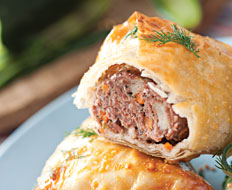With the benefit of hindsight, it seems obvious that the culinary revolution that has turned cooks into international celebrities, professional-grade Viking ranges into standard-issue home appliances, and ordinary citizens into connoisseurs of extra virgin olive oils and kosher salts would ultimately trickle down to the very humblest of food outlets.
You simply can’t get much less glamorous than the erstwhile food truck, those ungainly silver hotplates-on-wheels that brought hot dogs, doughnuts, and assembly-line coffee to office-park workers for generations. No one who’s ever eaten a humdrum tuna salad sandwich from these mobile commissaries likely would have expected the owners to attempt anything more ambitious.
And yet, the hottest meal ticket these days in many cities like New York, Chicago, L.A., San Francisco, and other major, trend-setting urban centers is the new gourmet food truck. As the downturn made the economics of high-end restaurants more challenging, many enterprising chefs took their acts on the road. They selected a signature dish or cuisine—typically inspired by one or more popular ethnic street foods—prepared the goods to order, and sold them from customized vehicles that often boast more marketing pizazz than your average Chuck E. Cheese.
The offerings aren’t just eclectic; they sometimes verge on the bizarre. Mobile sandwich servers, taco trucks, and pizza paddywagons we might expect to see, but crêperies, dumpling trucks, crème brulée carts, and Korean barbecue joints on wheels are serving fare worlds away from what used to roll off food trucks. In every case, however, the watchwords are affordable, portable, and authentic. Take street food too far from its humble origins and you risk compromising its populist cachet.
The reaction from both regular consumers and excitable foodies in the areas served by the most successful food trucks has been something verging on manic. Since many of these businesses notify fans of their upcoming whereabouts via Twitter, it’s not unheard of for hungry patrons to line up in advance of a truck’s arrival.
Debates rage online about the relative merits of Moshe’s Falafel, often stationed at 46th Street and 6th Ave. in New York, and the papusas and huaraches sold from Red Hook Trucks in Brooklyn. And the Food Network, never slow to catch on to the drawing power of emerging trends, has even found an audience for “The Great Food Truck Race,” in which seven teams compete for a $50,000 prize.
My view is that the street-food crazes that are conjured up in the cramped kitchens of the nation’s roving food trucks can be replicated in the more generous and well-stocked real estate of fast food and fast-casual restaurants.
Here are a few ideas for ways to incorporate the best ideas into your menu:
Consider unconventional carriers: When it comes to sandwiches, burgers, pizza, and the like, switching from a more traditional carrier—rolls, buns, basic breads, toasts—to an unusual ethnic alternative can have a transformational effect. The range of flavors and textures afforded by ethnic carriers from naan and foccacia to southern Indian dosas (chickpea pancakes) and Ethiopian injera (a spongy, succulent, uniquely North African staple) could provide the platform necessary for a reconfiguration of even longstanding menu mainstays. Think how much marketing mileage pizza chains have been able to wring from altering the thickness of their crusts and you’ll have a sense of how vast the possibilities are in this area.
Distill complex ethnic flavors down to their essence: As I discussed in last month’s column, the difference between a standard, somewhat uninspired breast of chicken and one that can legitimately be marketed as Italian is a little garlic, some parsley, and a hint of olive oil.
A Greek variant need only incorporate hints of tomato and cinnamon—that cuisine’s signature ingredients. Most of the world’s ethnic cuisines can be distilled down to their essences and used to create intriguing twists on familiar themes. Using any of these distinctive herb, fruit, vegetable, and spice combinations as the basis for marinades, shake-on seasonings, dipping sauces, or salad dressings can inject authentic street-food notes into existing menu items.
Small bites and sides from around the globe: Beyond giving today’s menu offerings a new suit of exotic clothes, operators may want to consider the variety of small bites that have bubbled up from the streets of Latin America and Southeast Asia as possible sources of inspiration for wholly new items. Fritters, empanadas, skewers, mini samosas, crêpes, arepas, and papusas—these sorts of small, “poppable” snacks or mini-meals—although somewhat exotic and highly accessible, could take their place alongside chicken tenders, jalapeño poppers, and potato wedges on any number of chain menus.
Just as high-end chefs such as Chicago’s Rick Bayless have turned street food favorites from churros to tortas into customer favorites at his phenomenally popular XOCO quick-service café, so too might quick-serve chains tap into street foods’ deep-rooted appeal to enliven their own menus. Doing so can ensure that your customers continue to hit the drive thru even as your smaller but nimble four-wheeled competition drives on and on.









